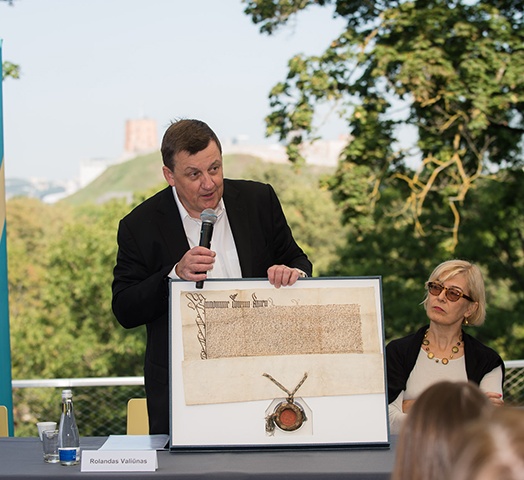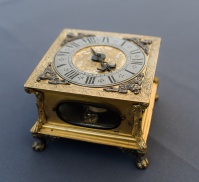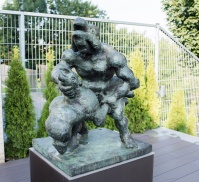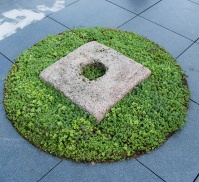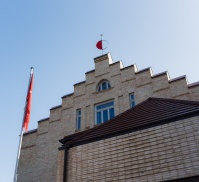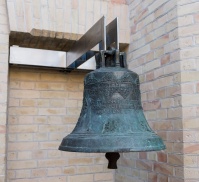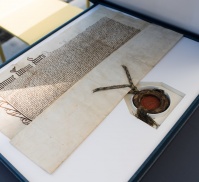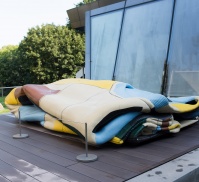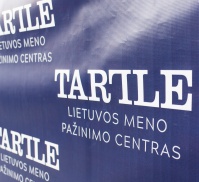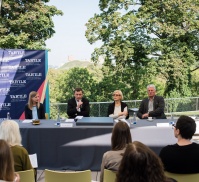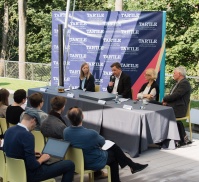The Lithuanian Art Centre Tartle is Opened
The Art Centre Tartle opened in Vilnius will feature unique exhibits of our history and art. From now on visitors of the private collection introduced in Užupis will be able to see live unique valuables of Lithuanian art and history, such as privileges of grand dukes of the Grand Duchy of Lithuania (GDL) written on parchment, one of the first books printed in Lithuanian – Postilla by J.Bretkūnas or one of the rarest masterworks of the 17th century – the watch by Jacob Gierke. Art fans will be able to admire more than 7 thousands of exhibits that also include the largest collection of paintings about Vilnius.
“From the very beginning as a collector of artworks I knew that I wanted to share and make the society aware of works that were brought back to Lithuania. On this special day, one of the largest private collections in Lithuania accumulated for almost 20 years becomes open to the general public”, Rolandas Valiūnas, the founder of the art centre and collector, says.
The target of the collection and the art centre founded by Rolandas Valiūnas is not only to collect and bring back to homeland the Lithuanian cultural and historical heritage scattered all over the world, but also – what is most important – to make it available to the general public and introduce Lithuania’s history through art.
The centre is unique as it will provide the possibility to get acquainted with Lithuania’s history through art, i.e. by seeing in person original art exhibits from different time periods that cannot be seen anywhere else. Among them will be the biggest private collection of medals and sculptures by Petras Rimša; a unique folk art collection; the only in Lithuania such large-scale collection of GDL maps; little-known albums by Franciszek Smuglewicz published in Rome; a collection of Lithuanian books of almost 2 thousand specimens; impressive graphic art collections by Kazimierz Wilczyński and Napoleon Orda; a full collection of inter-war Lithuania’s stamps; silverware by Vilnius masters, such as a unique watch by the most famous watchmaker of the 17th century in Vilnius, Jacob Gierke; the biggest sculpture in Lithuania by Jacques Lipschitz; a collection of works by the inter-war Vilnius artists, and many other valuable exhibits.
Most of works in the collection belong to the Lithuania’s Art Treasury and complement the national collections hosted in museums. They are often lent for Lithuanian heritage exhibitions both in Lithuania and abroad. For example, the painting Sacred Samogitia by Stanisław Jarocki was lent for the exhibition of artworks of Baltic symbolists at the Musée d'Orsay in Paris opened in the spring of this year. After the exhibition the painting will go to Tallinn museum KUMU and the Latvian National Art Museum in Riga.
In the first Tartle exhibition “A Glance at the History of Lithuanian Art from Užupis” visitors are invited to explore the peaks of Lithuanian art history. Artworks of the exhibition are attributed by specialists to the Lithuania’s Art Treasury. According to the historian of art and the curator of the exhibition, prof. dr. Giedrė Jankevičiūtė, the exhibition introduces the collection to the visitor in two aspects. “First of all, it introduces such Lithuanian art authors or such aspects of their artworks that are not represented in any other collections – national, municipal or private. Second, the gallery with its collection is located in the old town of Vilnius, thus visitors are offered an opportunity to view the surroundings of the gallery through the eyes of artists of different epochs”, Jankevičiūtė states.
As director of Tartle Jurgita Semenauskienė says, the Scottish word “tartle” not accidentally has been chosen for the name of the centre as this word defines the feeling when we do not recall what it is, where we have seen or heard it, wherefrom we know about it, but it is definitely familiar to us. “Such a feeling often overcomes us when looking at pictures, works of art or flipping through old books, Semenauskienė says. “Tartle” is a feeling which triggers curiosity and thirst for art knowledge. The name reflects the aspiration of the centre to provide its visitors with an opportunity to explore cultural heritage in more detail and to discover Lithuania’s history anew, through art“.
The Lithuanian Art Centre Tartle will feature the collection of the Lithuanian Art Foundation which currently comprises over 7 thousand of exhibits, including approximately 1,000 paintings, more than 360 sculptures, more than 490 maps, more than 1,100 pieces of historical graphics, more than 2,000 Lithuanian books and other publications issued before 1905. Examples of Lithuanian medal art, silver minting and other artefacts (ancient Lithuanian armour, guns, money, jewellery, etc.) are also being collected.
All the exhibitions held by the art centre will be visited by small groups guided by a professional art specialist, thus pre-registration will be required. It will be like a walk, talking about art with field professionals and developing a closer relationship with Lithuanian art, culture and history. The first several weeks after the opening will be intended for art specialists and historians to get familiar with the Tartle collections. The founders of the Lithuanian Art Centre: the Lithuanian Art Foundation (public entity) and collector Rolandas Valiūnas.
Online registration will start from 22 October.

The Art Centre Tartle opened in Vilnius will feature unique exhibits of our history and art. From now on visitors of the private collection introduced in Užupis will be able to see live unique valuables of Lithuanian art and history, such as privileges of grand dukes of the Grand Duchy of Lithuania (GDL) written on parchment, one of the first books printed in Lithuanian – Postilla by J.Bretkūnas or one of the rarest masterworks of the 17th century – the watch by Jacob Gierke. Art fans will be able to admire more than 7 thousands of exhibits that also include the largest collection of paintings about Vilnius.
“From the very beginning as a collector of artworks I knew that I wanted to share and make the society aware of works that were brought back to Lithuania. On this special day, one of the largest private collections in Lithuania accumulated for almost 20 years becomes open to the general public”, Rolandas Valiūnas, the founder of the art centre and collector, says.
The target of the collection and the art centre founded by Rolandas Valiūnas is not only to collect and bring back to homeland the Lithuanian cultural and historical heritage scattered all over the world, but also – what is most important – to make it available to the general public and introduce Lithuania’s history through art.
The centre is unique as it will provide the possibility to get acquainted with Lithuania’s history through art, i.e. by seeing in person original art exhibits from different time periods that cannot be seen anywhere else. Among them will be the biggest private collection of medals and sculptures by Petras Rimša; a unique folk art collection; the only in Lithuania such large-scale collection of GDL maps; little-known albums by Franciszek Smuglewicz published in Rome; a collection of Lithuanian books of almost 2 thousand specimens; impressive graphic art collections by Kazimierz Wilczyński and Napoleon Orda; a full collection of inter-war Lithuania’s stamps; silverware by Vilnius masters, such as a unique watch by the most famous watchmaker of the 17th century in Vilnius, Jacob Gierke; the biggest sculpture in Lithuania by Jacques Lipschitz; a collection of works by the inter-war Vilnius artists, and many other valuable exhibits.
Most of works in the collection belong to the Lithuania’s Art Treasury and complement the national collections hosted in museums. They are often lent for Lithuanian heritage exhibitions both in Lithuania and abroad. For example, the painting Sacred Samogitia by Stanisław Jarocki was lent for the exhibition of artworks of Baltic symbolists at the Musée d'Orsay in Paris opened in the spring of this year. After the exhibition the painting will go to Tallinn museum KUMU and the Latvian National Art Museum in Riga.
In the first Tartle exhibition “A Glance at the History of Lithuanian Art from Užupis” visitors are invited to explore the peaks of Lithuanian art history. Artworks of the exhibition are attributed by specialists to the Lithuania’s Art Treasury. According to the historian of art and the curator of the exhibition, prof. dr. Giedrė Jankevičiūtė, the exhibition introduces the collection to the visitor in two aspects. “First of all, it introduces such Lithuanian art authors or such aspects of their artworks that are not represented in any other collections – national, municipal or private. Second, the gallery with its collection is located in the old town of Vilnius, thus visitors are offered an opportunity to view the surroundings of the gallery through the eyes of artists of different epochs”, Jankevičiūtė states.
As director of Tartle Jurgita Semenauskienė says, the Scottish word “tartle” not accidentally has been chosen for the name of the centre as this word defines the feeling when we do not recall what it is, where we have seen or heard it, wherefrom we know about it, but it is definitely familiar to us. “Such a feeling often overcomes us when looking at pictures, works of art or flipping through old books, Semenauskienė says. “Tartle” is a feeling which triggers curiosity and thirst for art knowledge. The name reflects the aspiration of the centre to provide its visitors with an opportunity to explore cultural heritage in more detail and to discover Lithuania’s history anew, through art“.
The Lithuanian Art Centre Tartle will feature the collection of the Lithuanian Art Foundation which currently comprises over 7 thousand of exhibits, including approximately 1,000 paintings, more than 360 sculptures, more than 490 maps, more than 1,100 pieces of historical graphics, more than 2,000 Lithuanian books and other publications issued before 1905. Examples of Lithuanian medal art, silver minting and other artefacts (ancient Lithuanian armour, guns, money, jewellery, etc.) are also being collected.
All the exhibitions held by the art centre will be visited by small groups guided by a professional art specialist, thus pre-registration will be required. It will be like a walk, talking about art with field professionals and developing a closer relationship with Lithuanian art, culture and history. The first several weeks after the opening will be intended for art specialists and historians to get familiar with the Tartle collections. The founders of the Lithuanian Art Centre: the Lithuanian Art Foundation (public entity) and collector Rolandas Valiūnas.






